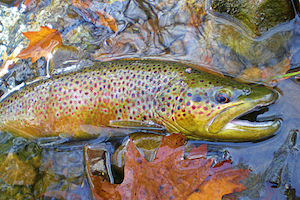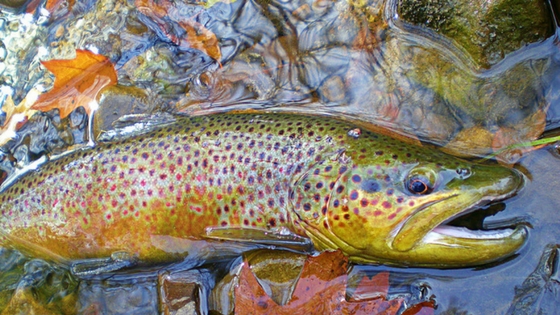Brown Trout Reproduction

Brown Trout spawn in the fall and early winter between the months, and including, October and February.
This corresponds to the same time that the speckled trout spawn.
Life cycle of the Brown Trout
They return to the stream where they were born and choose spawning sites that are spring-fed headwaters, the head of a riffle*, or the tail of a pool. Selected sites have good water flows through the gravel bottom.
The female Brook Trout uses her body to excavate a nest, also known as a redd, in the gravel. She and the male may spawn there several times in a single season and unlike most salmon, they don’t die after spawning.
A 5 lb/2.3 kilogram female produces about 3400 golden colored eggs that are 4 to 5 mm in diameter. The female Brook Trout cover their eggs with gravel after spawning and the adults return downstream.
The eggs develop over the winter at a slow rate so that they spawn in time for early spring. A good flow of clean, well-oxygenated water is necessary for successful egg development.
Hatching Brook Trout
After hatching, the young Brown Trout, called alevins, remain buried in the gravel and take nourishment from their large yolk-sacs. They stay there until the yolk sac has been used up.
By the time the yolk-sacs are gone, water temperatures have warmed to 7C° to 12°C. The young fry emerge from the gravel and begin taking natural food.
Brown trout fry are aggressive and establish territories soon after they emerge. They’re found in quiet pools or shallow and slow flowing waters where older trout are absent.
They grow rapidly and can reach 165 mm/ 6-5 inches in their first year.
The Brown Trout move into cobble and riffle areas. The adults are found in still deeper waters and are most active at night.
They are difficult to catch and are best fished at dawn or dusk.
- Brown trout living in streams grow to about 1.8 kg/4 pounds.
- Lake dwellers and sea-run fish grow larger.
Brown Trout mature in their 3rd to 5th year and many become repeat spawners.
Sea Run Populations
In sea-run populations, Brown Trout spend 2 to 3 years in freshwater then migrate downstream to spend 1 or 2 growing seasons in coastal waters near river mouths and estuaries. Brown Trout feed on small fish and crustaceans.
Most return to their home streams to spawn, but some straying occurs.
Brown trout live up to 14 years and can spend as long as 9 years in the sea.
*the rocky or shallow part of a stream



